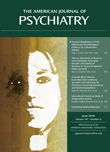Emotion Modulation in PTSD: Clinical and Neurobiological Evidence for a Dissociative Subtype
Abstract
Abstract
In this article, the authors present evidence regarding a dissociative subtype of PTSD, with clinical and neurobiological features that can be distinguished from nondissociative PTSD. The dissociative subtype is characterized by overmodulation of affect, while the more common undermodulated type involves the predominance of reexperiencing and hyperarousal symptoms. This article focuses on the neural manifestations of the dissociative subtype in PTSD and compares it to those underlying the reexperiencing/hyperaroused subtype. A model that includes these two types of emotion dysregulation in PTSD is described. In this model, reexperiencing/hyperarousal reactivity is viewed as a form of emotion dysregulation that involves emotional undermodulation, mediated by failure of prefrontal inhibition of limbic regions. In contrast, the dissociative subtype of PTSD is described as a form of emotion dysregulation that involves emotional overmodulation mediated by midline prefrontal inhibition of the same limbic regions. Both types of modulation are involved in a dynamic interplay and lead to alternating symptom profiles in PTSD. These findings have important implications for treatment of PTSD, including the need to assess patients with PTSD for dissociative symptoms and to incorporate the treatment of dissociative symptoms into stage-oriented trauma treatment.



